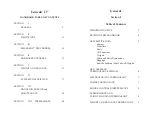Summary of Contents for 162 SKYLANE
Page 2: ......
Page 4: ......
Page 18: ......
Page 20: ......
Page 52: ......
Page 54: ......
Page 72: ......
Page 74: ......
Page 104: ......
Page 112: ...SECTION 5 CESSNA PERFORMANCE MODEL 162 GARMIN G300 U S Figure 5 1 162PHUS 00 5 10 ...
Page 114: ...SECTION 5 CESSNA PERFORMANCE MODEL 162 GARMIN G300 U S Figure 5 3 162PHUS 01 5 12 ...
Page 115: ...CESSNA SECTION 5 MODEL 162 PERFORMANCE GARMIN G300 U S Figure 5 4 5 13 162PHUS 01 ...
Page 116: ...SECTION 5 CESSNA PERFORMANCE MODEL 162 GARMIN G300 U S Figure 5 5 162PHUS 01 5 14 ...
Page 117: ...CESSNA SECTION 5 MODEL 162 PERFORMANCE GARMIN G300 U S Figure 5 6 162PHUS 01 5 15 ...
Page 118: ...SECTION 5 CESSNA PERFORMANCE MODEL 162 GARMIN G300 U S Figure 5 7 162PHUS 01 5 16 ...
Page 124: ......
Page 206: ......
Page 232: ......
Page 234: ......
Page 242: ......


































